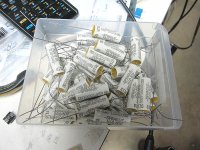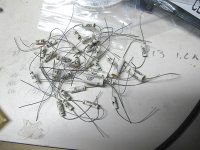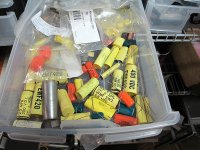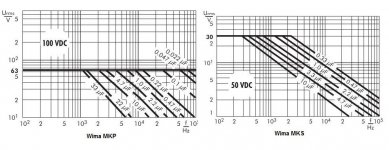Polyphenylene Sulfide (PPS) are very good , but not cheap.
WIMA SMD-PPS are in the range of $2-$3 for the larger values. Mostly in 5040 (12.7x10.1x0.7mm) or 6054 (15.3x13.7x0.7mm) size. They can easily be stacked.
WIMA SMP-PPS: From 0.01μF to 2.2μF.WIMA SMD-PPS are in the range of $2-$3 for the larger values. Mostly in 5040 (12.7x10.1x0.7mm) or 6054 (15.3x13.7x0.7mm) size. They can easily be stacked.
Last edited:
WIMA has all the desired values for sale in the smallest possible size. The quality is world class. Film capacitors Made in Germany. - WIMA – Competence in Capacitors
These plots depict allowed AC-voltage vs AC-frequency, dependent on nominal DC blocking voltage. This is interesting for resonant circuits where significant AC-voltage drop across the cap increases dielectric losses. For audio application with some mV AC across the coupling caps this is totally irrelevant.Are not great at what ?
What is Urms and V ?
U is an alternate symbol for a voltage, V is the symbol for volts (the unit).
(Just like we use I for a current, whereas A or amp is the unit).
In physics U is used to distinguish voltage from velocity, I believe. The same issue would
exist is A meant current (as it also means area). When describing electric motors etc its important not to confuse velocity with voltage!
(Just like we use I for a current, whereas A or amp is the unit).
In physics U is used to distinguish voltage from velocity, I believe. The same issue would
exist is A meant current (as it also means area). When describing electric motors etc its important not to confuse velocity with voltage!
U in physics is potential or internal energy, in Joules. This is not the same as Volts,
which has units of Joules per Coulomb.
which has units of Joules per Coulomb.
Last edited:
In Germany, and maybe other parts of Europe, voltage is U and not V.
I do have some 10uF/16V WIMA capacitors.
About 60% of the volume of 50V ones, but they are no longer available.
Probably the foil is just too thin to handle safely. And the minimum stable
foil handles 50V easily. I did a board design under the assumption I could
get more of them. 😡
RajkoM:
> As far as I know, "Iskra" copied German ERO capacitors.
> Polycarbonate is a great sounding capacitor.
There is not much IP to copy two pairs of foil in an epoxy blob.
The fact that it is easy to wind your own is the business opportunity
for some "hi end" manufacturers. If the don't delegate that at all.
Don't get me started about capacitor "sound".
/Gerhard
I do have some 10uF/16V WIMA capacitors.
About 60% of the volume of 50V ones, but they are no longer available.
Probably the foil is just too thin to handle safely. And the minimum stable
foil handles 50V easily. I did a board design under the assumption I could
get more of them. 😡
RajkoM:
> As far as I know, "Iskra" copied German ERO capacitors.
> Polycarbonate is a great sounding capacitor.
There is not much IP to copy two pairs of foil in an epoxy blob.
The fact that it is easy to wind your own is the business opportunity
for some "hi end" manufacturers. If the don't delegate that at all.
Don't get me started about capacitor "sound".
/Gerhard
What do you think of these : Panasonic polypropylene 250 V . Different and smaller than wima & kemet for 250V and these uF's :
Panasonic ECWF(A) Series 250 VDC Film Capacitors | Mouser
Panasonic ECWF(A) Series 250 VDC Film Capacitors | Mouser
Oh, yeah, I've used those a LOT--they're excellent! Just a bit on the large side; OK in many applications, but not all.What do you think of these : Panasonic polypropylene 250 V . Different and smaller than wima & kemet for 250V and these uF's :
Panasonic ECWF(A) Series 250 VDC Film Capacitors | Mouser
Oh, yeah, I've used those a LOT--they're excellent! Just a bit on the large side; OK in many applications, but not all.
For what audio application are they not ok ?
Not ok for microphone preamplifier 48V phantom power isolation where I need 33μF or 10μF +.
but what level of distortion can you tolerate?
referencing the article I cited previously, capacitor distortion is related to voltage (measured by Sam and Scott in dBu). at the levels of a microphone signal the capacitor distortion should be less than the threshold
Please describe this 'Nakamichi' arrangement.I will mostly use them as input caps and as coupling caps in a "Nakamichi" type feedback arrangement (anything to avoid putting an electrolytic in series with my feedback network).
Dan.
Where they simply won't fit.For what audio application are they [Panasonic polypropylene 250 V] not ok ?
I've used the Wima 63V (perhaps 50V, recollection is Hazey), and they are just about the most compact through hole caps available. It is very easy to abuse these and cause then to fail, by even a small surge over they rating. I got sick of paying £2 or more pu, for them to fail where a larger 63V rated capacitor wouldn't.
The biggest issue I have with them is sheer price, they arent cheap, or good value, but simply the most compact.
In higher voltages, such as 600V/630V, I've found that Epcos or Kemet are the most compact box style easily available, and they're cheap too.
The biggest issue I have with them is sheer price, they arent cheap, or good value, but simply the most compact.
In higher voltages, such as 600V/630V, I've found that Epcos or Kemet are the most compact box style easily available, and they're cheap too.
Last edited:
- Home
- Design & Build
- Parts
- polypropylene capacitors



